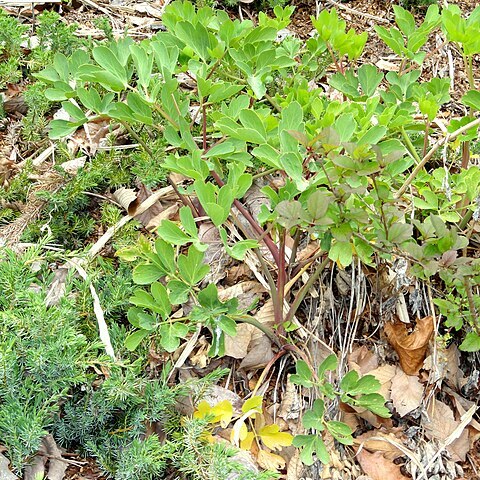Taproot elongated fusiform, apex with erect remnants of sheath nerves 1 cm long; flowering parts puberulous otherwise glabrous. Stem terete, grooved, slightly flexuose, erect, often branched, ½-¾ cm diam., solid, 15-100 cm tall. Branches with distinct nodes, alternate, rather erect. Basal leaves in large specimens long-petioled with 3 bi-jugate, long-stalked, ternate segments, blade c. 30-40 cm diam.; leaves of small specimens and flowering stems much smaller, 7-10 cm diam., biternate; petiole 3-5 cm sheathing over its entire length, amplexicaulous at the base, striate; lateral segments ½-2 cm petiolulate, terminal ones 1½-4 cm, all 3-parted; leaflet-segments sessile, often connate at the base, lateral ones oblique, all obovate-cuneate, margins entire, apex broadened 3-5-toothed or-lobed, lobes often dentate, about equal in size 2½-4 by 1-3 cm; uppermost leaves reduced. Inflorescence corymbiform. Compound umbels terminal, 4-7 cm wide; peduncle 6-7 cm, in fruit to 10 cm, stout, striate, erect. Rays 15-25, unequal in length, ½-2½ cm. Involucres 0. Secondary peduncles in flower 1-2, in fruit 2-3 cm long, hardening. Involucels 7-10, subequal or very unequal, lanceolate-oblong, acute, 2-6 mm. Pedicels 17-20, in flower 1-2 and 4-5 mm, outer largest, in fruit hardening but not elongating. Flowers not radiant. Calyx indistinct. Petals ? white, c.1¼ by 1 mm, emarginate through inflexed tip. Stamens inflexed in bud; filaments 2 mm. Stylopodium blunt, very thick, cap-like covering tip of ovate ovary and as broad as it, margin crenate. Styles 2, exceedingly short. Fruit partly abortive, 5-6 by 2½-3 mm, elliptic, crowned by the stylopodium. Mericarps dehiscing from the base, pendent from the filiform carpophore halves, minutely puberulous to sub-glabrous, marginal wing ca⅓-½ mm broad, ventral side rather flat, through wing subconvex; body darkish, wings and ribs pale brown (description after Japan, specimens in Rijksherbarium).
More
Plants stout, (30–)40–70(–100)cm, essentially glabrous. Stem often flexuous. Leaf blade broadly ovate-triangular, to 35 × 25 cm, thinly coriaceous, 1–2-ternate; leaflets ovate-orbicular, 3-parted, 7–9 cm broad, glaucous; central segments obovate-cuneate, lateral segments oblique-ovate. Umbels (4–)5–10 cm across; bracts 2–3 or absent, ovate-lanceolate, 5–10 × ca. 2 mm, pubescent; rays 15–30, 1–5 cm, unequal, puberulous; bracteoles 8–10, linear-lanceolate, equaling or longer than flowers; umbellules ca. 20-flowered. Calyx teeth obsolete. Petals purple or white, abaxially hispidulous. Styles short. Fruit oblong-ovate or ellipsoid, 4–6 × 2.5–4 mm, hirsute, especially on dorsal ribs; lateral ribs winged, wings very thick; vittae small, 3–5 in each furrow, 6–10 on commissure. Fl. Jun–Jul, fr. Aug–Sep.
A herb. It is stout and grows 40-70 cm tall. The stems are flexible. The leaves are broadly oval or triangle shaped and 35 cm long by 25 cm wide. They are divided. The leaflets are oval or round and 7-9 cm wide with 3 parts.

